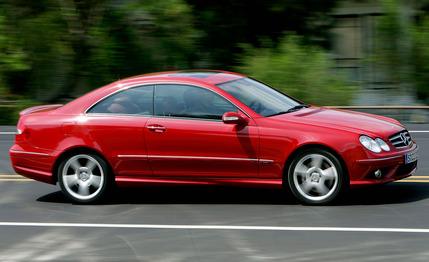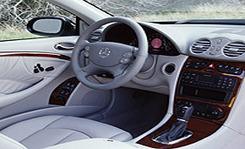 First Drive Review
First Drive Review
Here's a moderately interesting anthropometric fact: The human race has been gaining altitude, adding about four inches in height over the past century or so.
Seemingly unrelated automotive fact: Of all its vehicles, Mercedes' two-door models are most likely to survive as collector cars.
Connective logic leap: To ensure the comfort of future king-size car buffs in its redesigned CLK model, Mercedes-Benz has raised the roof by 1.7 inches, gaining another quarter-century's worth of front-seat head comfort (0.9 inch).
Sexy styling sells two-door cars such as the CLK, usually at some expense to practicality. Conventional wisdom would suggest, then, that to increase sales, one should make changes that enhance the style. Yet Mercedes admits that practical packaging concerns motivated the stylistically counterintuitive measure of raising the original CLK's slinky, low-slung roofline and stretching its wheelbase by an inch.
The package is undoubtedly better. Front-seat occupants sit taller relative to the high cowl and dash--this is still a C-class sedan underneath--and there's ample room for modern humankind in back. To maintain the old car's proportions, the new one's ducktailed tush cantilevers 2.6 inches farther out the back. The new shape loses some sportiness but gains elegance, especially with the windows rolled down. Like its CL-class sibling, the CLK has no B-pillar structure to clutter its classic hardtop greenhouse.
The taller roof and a 0.7-inch increase in width add almost a square foot to the frontal area, but the drag coefficient drops from 0.31 to 0.28, reducing overall drag by five percent. Extensive underbody smoothing and sculpting also helped to reduce lift substantially--by 73 percent in front, 36 percent in back. The aero work also cuts wind noise dramatically. Even when driving at 70 mph with all the windows down, the cockpit remains calm and quiet.

Ovals and ellipses abound inside a ritzy-looking new cabin, and front and rear seats afford long-haul comfort and support. Close the door, and the seatbelt motors out to meet your hand. Adaptive cruise control, keyless starting, and sonar parking assist are among the sybaritic options newly added. Our only niggle concerns the instrument cluster, which devotes one entire dial to a clock, relegating the fuel and temp gauges to narrow digital bar graphs that are harder to interpret.
Body rigidity is up 40 percent in torsion despite the lack of a structural B-pillar. Easily replaceable bolt-on front and rear crash modules save money in fender-benders under 10 mph, and in bigger shunts, all passengers are now protected by side and window-curtain airbags. Naturally, the bigger, better-equipped CLK is also heavier--by a discouraging 300 or so pounds.
To help launch the extra load, the V-6-powered CLK320 is geared 6.5 percent shorter, but the new car is about a second slower to 60 mph, according to Mercedes-Benz's stopwatches. The V-8 car gets a 10-percent power bump to 302 horses, courtesy of an extra 700cc of lung capacity and a promotion to CLK500 nomenclature. Don't expect much extra zip, though--the power-to-weight ratio remains about the same, and the gearing is fractionally taller. Company figures claim 0 to 62 mph in six seconds, 0.3 second quicker than the outgoing CLK430. The rip-snorting CLK55 AMG model will pack a 362-horse punch (that's 20 up on the current model) and the same 367 pound-feet of earth-spin-altering torque when it arrives, along with the CLK cabriolet, next year.
Down in the chassis department, the steering is upgraded (at long last) to rack-and-pinion hardware, and the CLK500 gets huge new four-piston front and two-piston rear calipers and front rotors that are bigger than those on last year's CLK55 AMG. Rotating the tires is a thing of the past, as all CLKs now come with rear tires that are larger than the fronts.
To take the measure of all these enhancements, Mercedes turned us loose on the verdant undulating byways of France's Beaujolais wine region. We found the steering to be significantly improved over the outgoing model's. There's much less of a dead spot on-center, effort builds naturally, and the car turns precisely as one expects it to. There's none of the road-surface-texture definition that one finds in a BMW, and the proximity to the limits of adhesion are not quite as well transmitted, but we generally approve of the new CLK's helm.
As we expected, two-lane passing with the V-6 requires a bit of planning, but the transmission is cooperative and the engine transmits pleasing sounds as it labors. The CLK500 puts its power down decisively and makes quick work of overtaking, but we found the electronic throttle programming to be a bit too jumpy, calling for more thrust than our foot angle intended. Then again, the throttle-by-wire programming is adaptive, so maybe it had been acclimated to a previous jerky-footed pilot.
We've pitted CLKs against 3-series two-doors in the past, and their softer demeanor and lack of a manual transmission has handicapped them with the hotshoes here. This larger, heavier one may not reverse that trend, but among paying customers, the CLK is the global sales leader in its class, so maybe Mercedes is on the right track after all. Just please don't make the next one any taller--evidence suggests the human race is now mainly growing wider.